
The Capitol Dome highlights the view as we walked out the front doors of DC’s Union Station, and instantly we knew we were in a city like no other in America.
Or anywhere else for that matter.
Just outside the station, there were bikes for rent — so we hopped on a couple of trusty steeds and headed out toward the National Mall.
The Capitol Building: a capital idea!
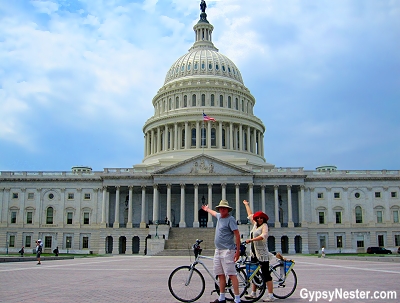
The main attractions of Washington are spread out over several miles, so walking from monument to monument could have easily eaten up most of our limited time in DC.
Pedaling along the extremely bike-friendly paths through the Mall area solved our time issues and prevented mighty tired tootsies by the end of the day.
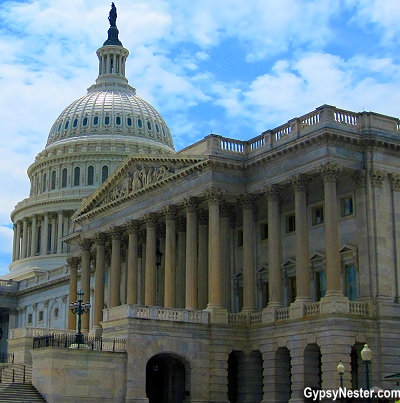
If any one of the dozens of iconic buildings and monuments in the District of Colombia can symbolize the city — perhaps the entire country — it must be the Capitol.
President George Washington himself laid the cornerstone on September 18, 1793 and the first session with both houses of congress was held in November of 1800.
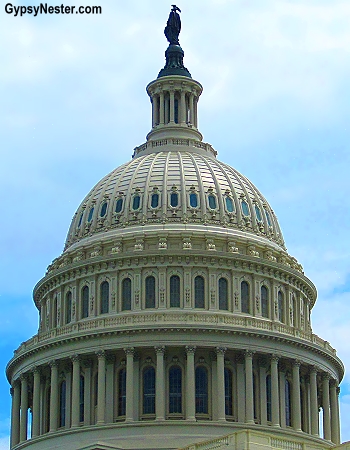
The construction was nowhere near finished at that time, but our government had a home. In fact, construction continued for well over a century.
From our first vantage point in front of the east steps, we could easily see the difference in stone between the original structure and the expansion that began in 1850.
That expansion added the Capital Building’s most recognizable feature, the dome. The expanded capitol was so large that the original dome looked pretty puny, so in 1855 a fitting cupola was created.
We most certainly applaud the decision as a capital idea, it just wouldn’t be the same without it.
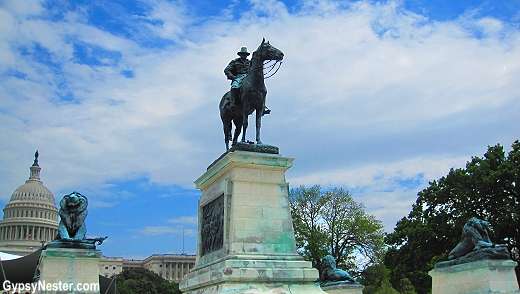
The White House
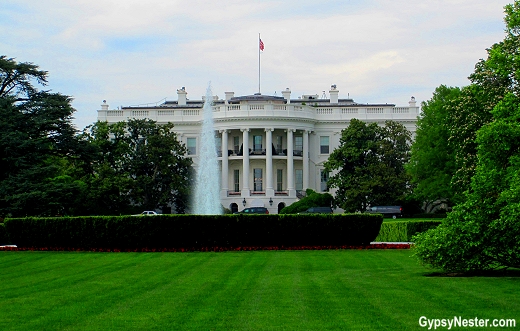

Before we set out to see the monuments, we headed over to the most famous residence in town, 1600 Pennsylvania Avenue. Built from 1792 to 1800, the house wasn’t finished in time for George Washington to move in, but every president since has lived in it.
Like the Capitol, The White House has been a work in progress, with numerous additions and renovations, and both were burned by the British in 1814, during the war of 1812. James and Dolley Madison were forced to move out but repairs began immediately, so by 1817 the new president, James Monroe, moved in.
That kept the streak alive.
At first no one was sure what to call it, the President’s Palace, the President’s House, or the Executive Mansion. Over time people dubbed it the White House, and in 1901 President Theodore Roosevelt made it the official name.
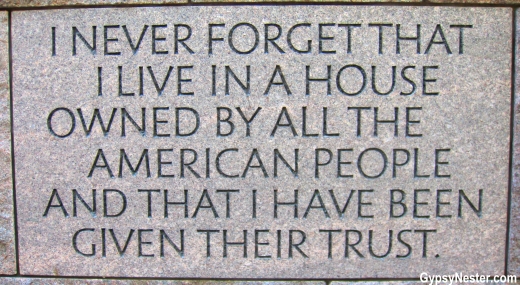
The Washington Monument
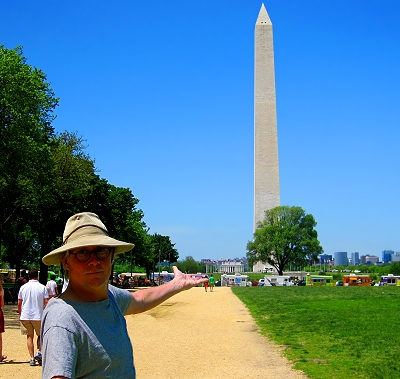
After meeting in Philadelphia, New York, and briefly in several smaller cities, the founders realized that their new nation needed a permanent seat of government.
So in 1790 congress passed the Residence Act creating a capital along the Potomac River.
President Washington picked the site and appointed Pierre Charles L’Enfant to draw up a plan for the new city. L’Enfant’s vision was of grand avenues, a huge open mall, and canals for delivering goods.
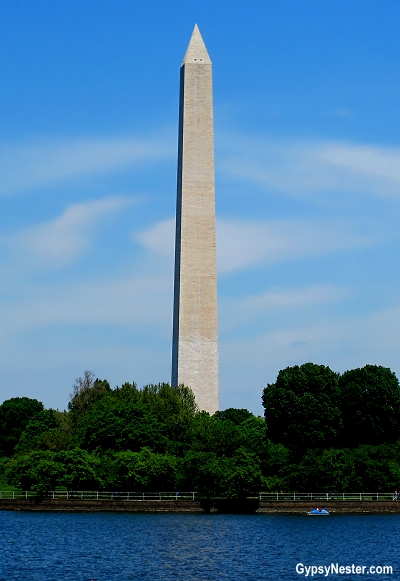
Though he fell out of favor and Washington replaced him with Andrew Ellicott, the final design remained close to the L’Enfant proposal.
Most all of the important buildings and monuments are on, or near, The Mall, which is centered around the towering Washington Monument.
Lucky for us, the scaffolding from repairs due to the 2011 earthquake has recently been removed, so we had an unobstructed view of all 555 feet of the obelisk.
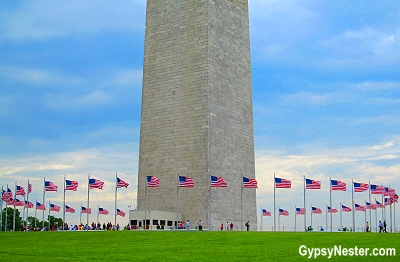
Construction took thirty-six years, but no work was done during twenty-two of those due to disagreements involving commemorative stones.
Things got out of hand as groups used inscriptions on the stones to promote all sorts of causes that had nothing to do with our first president. When the Know-Nothings took control of the Washington National Monument Society and stole a stone donated by the pope, things really fell apart.
They ran out of money and did such a poor job that all of their work had to be removed once work resumed again after the Civil War.

We easily noticed the different times of construction by the color of the stones, an obvious change occurs about one third of the way up.
When it was finally completed in 1884 it was the tallest structure in the world, a title held briefly – the Eiffel Tower topped it just five years later.
The Memorial to the Fifty-six Signers of the Declaration of Independence


Our next stop was one of DC’s more overlooked monuments, the Memorial to the Fifty-six Signers of the Declaration of Independence, dedicated in July 1982.
On a small island in Constitution Gardens, an arc of stone blocks depicting each signer’s signature is arraigned in groups by the colonies that they represented.
While we were familiar with the names of many of these patriots, especially the contingent from Boston, we are surprised by how many we did not recognize.

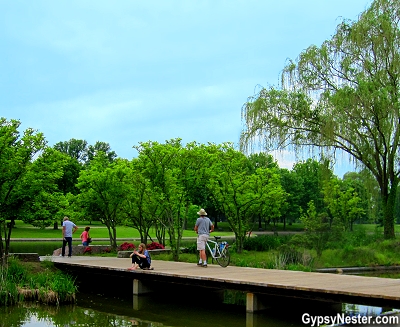
Constitution Gardens is the part of The Mall that runs along the north side of the reflecting pool between the Washington Monument and the Lincoln Memorial.
We headed further west along the park until we reached the Vietnam Memorial.
The Vietnam Veterans Memorial

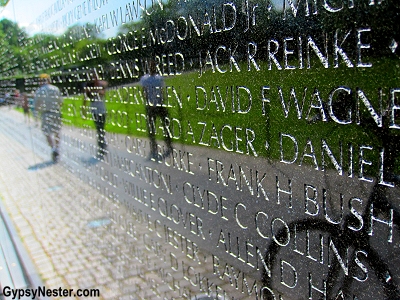
Dedicated in 1982 and designed by Maya Ying Lin (who also created the Civil Rights Memorial in Montgomery, Alabama), the Vietnam Veterans Memorial is a stark and solemn black granite wall engraved with the names of over fifty-thousand servicemen and women.
Each gave their life in the conflict, or remain missing.
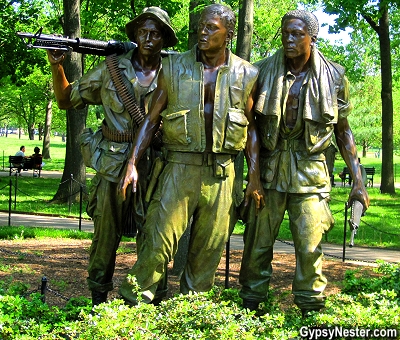
Near The Wall, stands The Three Servicemen, created by Frederick Hart.
Not everyone was happy with Ms. Ying Lin’s abstract design and some called for a more traditional statue.
The sculpture, unveiled in 1984, stands facing The Wall as if the men are looking over their fallen friends.

The Vietnam Women’s Memorial, by Glenna Goodacre, is dedicated to the thousands of women who served in Vietnam.
A wounded soldier is depicted with Charity – who holds him in her arms, Hope – looking to the sky – and Faith – who is kneeling in prayer.
The Lincoln Memorial

When we reached the west end of The Mall, we were standing right at the feet of the Great Emancipator and his stature and his memorial were just too imposing to ignore.
Climbing the steps where Dr. Martin Luther King delivered his I Have a Dream speech, it is hard not to feel it is the most inspiring monument in our nation’s capital.
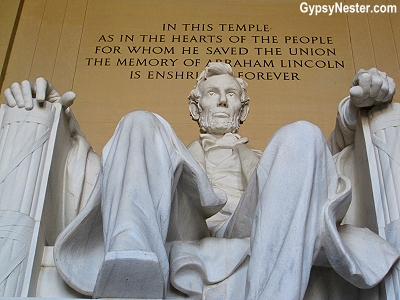
Styled after a Greek temple, it has a classic appearance that houses an enormous statue of the President.
The original plan was for a likeness only ten feet high, but that seemed much too small for the surroundings, so the size was doubled.

We heartily agree with that decision, Lincoln should certainly be remembered as larger than life.
Many of the monuments we’d seen have National Park Rangers guiding tours, or simply on standby for questions from curious types like ourselves.

We were lucky to find ourselves a guide who was willing to debunk a couple of myths about ole Abe’s likeness for us.
Myth One: Mr. Lincoln’s hands were positioned to spell out his initials – A & L – in sign language.

This myth most likely started because Daniel Chester French, the statue’s creator, has another sculpture on display in DC entitled Thomas Hopkins Gallaudet and Alice Cogswell.
That statue depicts Gallaudet, who opened the first school for the deaf in the US, and a young girl signing the letter A. Intentional for Miss Cogswell, not so much with Lincoln.
Myth Two: On the back of Lincoln’s head is Robert E. Lee. This was done to signify a yin-yang of the Union and the Confederacy.
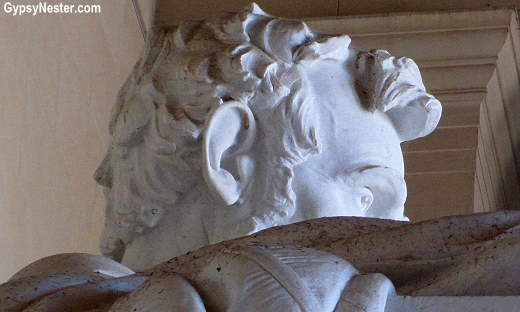
Nope. It’s just Lincoln’s hair. But it’s hard to un-see once it’s pointed out.
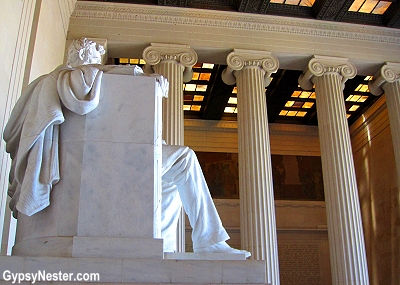
Another fascinating feature is the thinly cut marble tiles in the ceiling.
Soaked in beeswax to become translucent, the perfect amount of light is let in to highlight this incredible work of art.
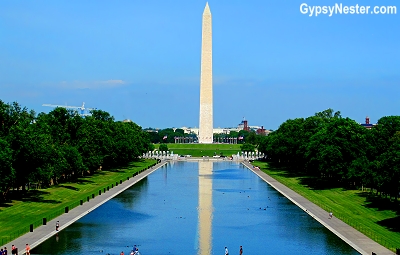
Trotting down the fifty-seven steps (no myth involved here, it’s simply a number of steps to have) to climb back aboard our trusty bikes, we were waylaid by the view!
Hey, isn’t that where Jenny ran through the water to get to Forrest Gump?
The Martin Luther King Memorial
From the site of the I Have a Dream speech we made our way to the nearby Martin Luther King, Jr. Memorial.
After over twenty years of planning and building the memorial opened to the public in August of 2011, and is one of the few in Washington not dedicated to a president.
We passed through two huge stones that symbolize a mountain of despair, to the Stone of Hope, which is the centerpiece of the monument.
The path was designed to signify the journey toward civil rights and named for the line from that famous speech “Out of a mountain of despair, a stone of hope.”
A relief of Dr. King is carved in the stone, and a granite wall is inscribed with lines from many of his sermons and speeches.
We’ve followed the footsteps of Dr. King through travel – see many more MLK tributes we’ve found
The Roosevelt Memorial
Spread out over seven and a half acres, FDR‘s memorial was designed by landscape architect Lawrence Halprin to encompass the twelve years that Roosevelt served as president.
The sculptures are fascinatingly life-like, addressing the great depression with a bread line of weary bronze figures and a citizen anxiously listening to a fireside chat.
We followed the path through the massive granite blocks, inscribed with quotes from the 32nd president, that mark off the sections.
One of these features a bronze statue of Eleanor Roosevelt, making this the only presidential memorial that includes a first lady. Even better, the sculpture celebrates Mrs. Roosevelt as the first US delegate to the United Nations.
Follow us around the Franklin D. Roosevelt Presidential Library and Museum in New York!
The George Mason Memorial
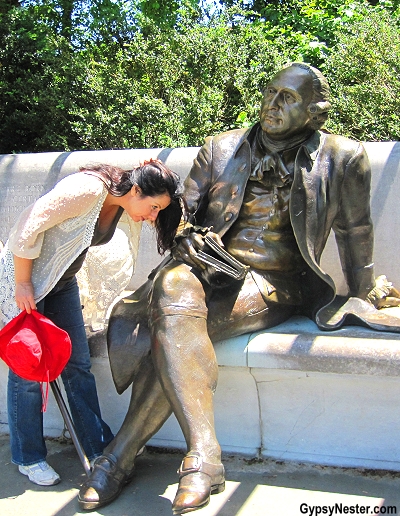
Mason is sometimes called the Forgotten Founder, but his contribution to the constitution should be unforgettable.
Having written the Virginia Declaration of Rights, the state sent him to the Constitutional Convention where he had a major impact. Ironically, he refused to sign the final document, feeling it did not provide the proper protections for individual freedoms.
He lobbied for a Bill of Rights, which was later adopted and closely resembled his earlier Virginia Declaration. Perhaps that is why he looks so content and comfortable on his bench gazing across the water toward The Mall.
The Jefferson Memorial

From the man behind the Bill of Rights, we biked over to the author of the Declaration of Independence.
The last of the memorialized founders we visited is Thomas Jefferson. Another classic design, the Jefferson Memorial is based on the Pantheon in Rome, and Jefferson’s own design of the Rotunda at the University of Virginia.
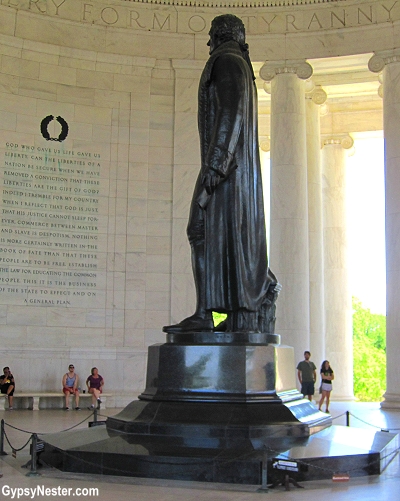
In the center, a five-ton bronze statue of our third president stands looking past the Washington Monument toward the White House.
He is surrounded by excerpts from the Declaration of Independence and quotes from several of his letters.
As we looked out over the tidal basin at our nation’s capital with Jefferson, we can’t help but feel that we had found a kinship with our nation’s historic leaders.
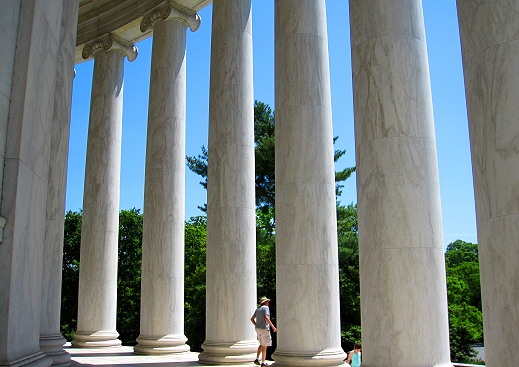
David & Veronica, GypsyNester.com
Delve deeper:
See more of DC’s incredible Union Station!
See our full Founding Cities Tour by Train through Boston, Philadelphia, Washington DC and New York City
Thanks to Amtrak for providing the train travel portion of this adventure through Boston, Philadelphia, New York, and Washington, DC! As always, all opinions are our own.


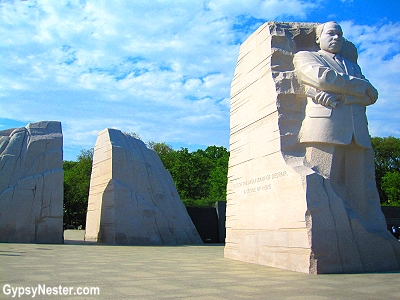
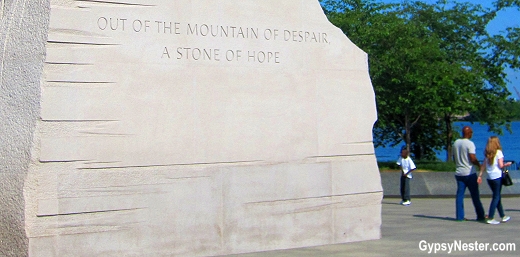
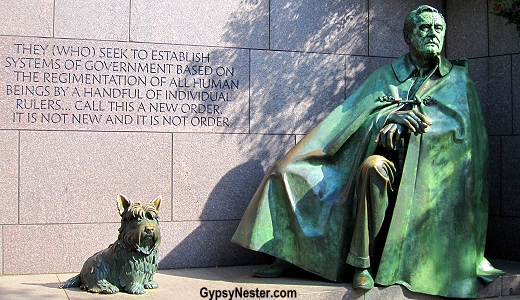

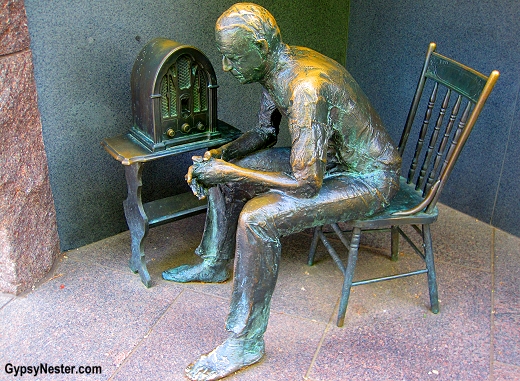

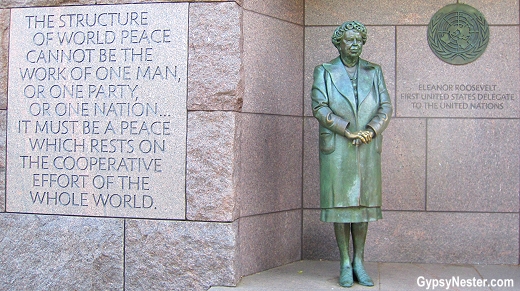

Seriously interesting stuff shared. Value content. Loving it
Dead indited articles, thankyou for selective information.
I live in Boston and San Francisco, and visit D.C. about every five years. It’s a vibrant city, beautiful monuments, and many of the museums/sites are free admittance. My nieces and nephews now work and live in D.C., since it’s ‘the’ place for the young now.
Was just in DC last week and used the Capital Bikeshare program to get around to sites. It was great. I find the most compelling monument to be the one marking the Korean War. It kind of takes your breath away when you come upon it.
Bikes are a great way to see the capital. Liked the Korean War memorial too, it’s very powerful.
DC is a great city for riding bikes & the infrastructure for biking gets better by the month so you can easily ride the cycle tracks, bike lanes & trails all over the city. It’s a great way to see Rock Creek Park a one of the largest urban parks in the US. Also A while down on the Mall near the Lincoln Memorial is the Korean War Memorial which is haunting & also a ‘must see.’ That area is also wonderful to tour at night – all very haunting & beautiful in the dark.
It was great by bike! And you are so right about seeing the Mall at night. Our oldest went to school at American University so we had the chance a few times back then.
My husband and I went biking with two friends last fall in DC. Despite the government shutdown, we were able to get close to most of the monuments. It was a novel way to tour the city and we enjoyed it very much. The National Mall was practically deserted so we didn’t have to worry about running over people 🙂 Next time we’ll go when everything’s open….
The monuments are very impressive even if you can’t go inside, and how great to not have any crowds to contend with!
I’ve never thought to ride a bike in DC. The traffic can be pretty intense, especially with those traffic circles. On the Mall, I would think it would be difficult to ride on the paths during tourist season. However, you guys obviously managed it, so perhaps I need to rethink this. Did you get to the Newseum? Is not run my the Park Service and had a fee, but it’s fascinating—covering journalistic history.
The bikes worked out great. Every now and then we had to be careful with crowds but it sure beat walking. Didn’t make it to the Newseum though.
DC is an amazing city with so much to see. And bicycles were a smart choice since parking is pretty much nonexistent. Never walked so much!
Bikes were a good choice, things are pretty far apart.